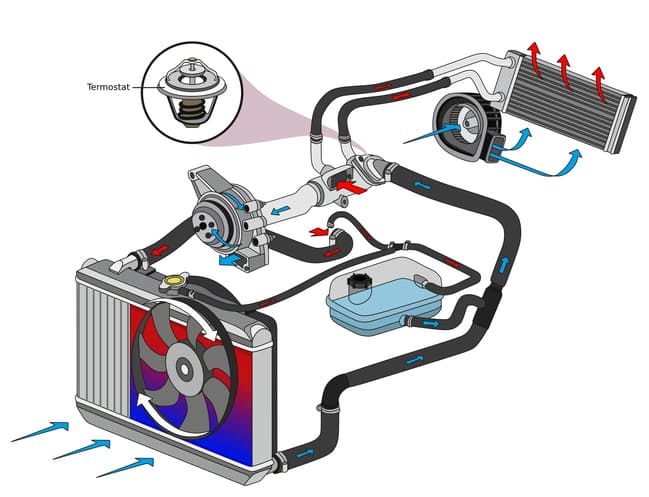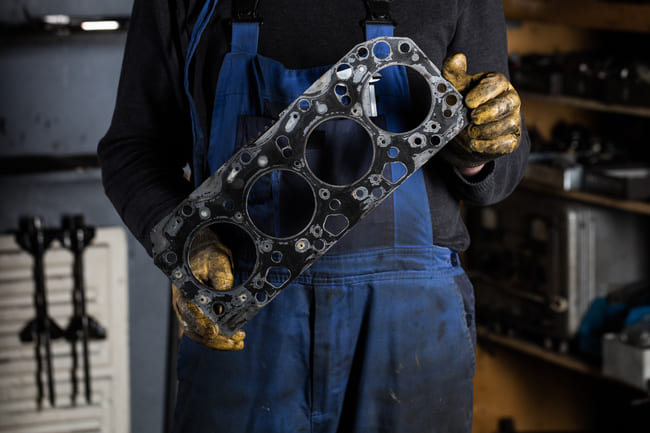
If your engine is overheating then it is important to act fast act. First of all, you should switch it off as soon as possible so that there is no serious damage. There are a number of possibilities that could be the cause. These include, for example, a lack of coolant, a defect in your cylinder head gasket or a failed water pump. In addition, consequential damage from an overheated engine can also be caused by a defective thermostat. In the following article, we explain how your engine's cooling system works, how you can check its function regularly and how this helps to extend the life of your engine.
Contents
How to recognize that your car is overheating?
There are some unmistakable signs that your engine is overheating. This includes, for example, that your engine fan runs continuously or that the temperature display in the car keeps rising. If you do not act immediately in such a case, real engine damage can occur, which cannot be repaired or can only be repaired at great expense. The most important system in this regard is your cooling circuit. So that you understand its function and know where problems can arise, we will explain its structure and function in more detail.
Tasks and function of the cooling system

When your engine is running, fuel is burned, with much of the energy released being dissipated as heat. The heat is a by-product, which can only be used to a very limited extent and often only on cold days to heat the interior. The excess thermal energy must therefore be dissipated from the engine block as efficiently as possible so that it does not become hotter and hotter. Otherwise, important engine components could fail or your entire engine block could warp. For this reason, all vehicles today are equipped with a modern cooling system, also because air cooling while driving has not been sufficient for a long time.
After combustion, the heat generated is transferred to the coolant via the engine components. This is located in the car's cooling circuit. The water pump circulates the coolant so that the waste heat can be dissipated to the engine cooler. This is where the heat exchange with the outside air takes place, whereby a suitable motor fan can support this if necessary. This is particularly necessary when the vehicle is stationary with the engine running or is driving rather slowly. The cooling system is controlled with the help of a thermostat. Diesel engines in particular often have an additional heater in the cooling circuit, also to be able to reach the operating temperature of the engine more quickly after starting.
What happens if the engine gets too hot?

One speaks of an optimal operating temperature of the engine when this is in the range of about 80 to 100°C. At higher engine temperatures, component wear increases significantly because the friction of all components increases significantly. You should note that an engine that is too cold also tends to have significantly higher wear. If the coolant temperature is significantly too high, the pressure also increases significantly, which can also lead to bursting of the cooling system lines. In such a case, severe engine damage is often the result. When the engine overheats, the exhaust gas values achieved often deteriorate and it is not uncommon for leaks or operating fluids to escape. However, all of these problems are often warned of by a warning light when your engine is overheating.
Causes for an overheated engine

If your engine overheats, this can have various causes. There are various factors that can cause the coolant temperature to be too high. First of all, you should think of the obvious and check whether there is even sufficient coolant in the system. This is possible if you check the fluid level in the associated expansion tank. However, you should make sure that your engine has cooled down before you open this container. Otherwise the escaping steam can cause severe scalding! If you notice that the fluid level is too low, the next step is a visual inspection of the relevant connections, hoses and lines. If you can't see any obvious leaks, then top up the coolant and then observe whether the coolant level drops again. If this is the case, you must look for the causative leak and eliminate it.
Problems with the water cooler can also lead to overheating. This quickly causes damage to the engine due to overheating if the air supply is not sufficient. So check whether the air supply is guaranteed, whether the cooling fan is free and also turns. Contamination of the cooler can also be the cause and should be removed. Sometimes a plastic bag lying on the street gets caught and blocks the air flow. The next step is to check the permeability of the radiator. To do this, you should let the engine warm up but not overheat. The radiator hose on the underside of the radiator should now also be warm. If this is not the case, it can either be due to a clogged radiator or a defective thermostat.

If the cylinder head gasket is defective, the engine temperature also very often increases significantly. This is because cooling water gets into the combustion chambers and is simply evaporated there. Such problems can be recognized by a continuous decrease in the coolant level or a loss of engine oil, although there are no residues of these working fluids under the vehicle.
Other causes are a defective radiator fan (see air supply), insufficient delivery by the water pump or a lack of switching between the two cooling circuits. It should be noted that modern vehicles usually have a small (without a cooler for preheating) and a large (with a cooler) cooling circuit. Blockages in the area of the thermostat can, for example, mean that it is no longer possible to switch between the two.
Conclusion
An engine that is too hot is not to be trifled with, because it is not unusual for an overheated engine to cause major damage. After turning off your engine immediately, you can run some diagnostics yourself to better isolate the problem. If you have learned how to handle chemicals and coolants yourself, and have the appropriate equipment and the necessary workshop, you can easily fix some of them yourself. In all other cases, we recommend that you contact your trusted specialist workshop.
A tip from CarTipsandmore: If the coolant warning light comes on, this can also mean that there is not enough antifreeze in the cooling circuit is present. However, very few drivers know that too much antifreeze or too little water can lead to similar symptoms. For this reason, you should measure your coolant using a forest protection measuring spindle or a suitable alternative device and then adjust the ratio between water and antifreeze.
